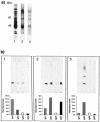Negative immunodiffusion test results obtained with sera of paracoccidioidomycosis patients may be related to low-avidity immunoglobulin G2 antibodies directed against carbohydrate epitopes
- PMID: 12965908
- PMCID: PMC193913
- DOI: 10.1128/cdli.10.5.802-807.2003
Negative immunodiffusion test results obtained with sera of paracoccidioidomycosis patients may be related to low-avidity immunoglobulin G2 antibodies directed against carbohydrate epitopes
Abstract
Immunodiffusion (ID) is the serologic test most frequently used for the diagnosis and posttherapy follow-up of patients with paracoccidioidomycosis (PCM). The ID test is highly specific (100%), but its sensitivity is relatively low (90%), leading to false-negative results. The aim of this study was to determine the profiles of antibodies in sera from patients with proven PCM and with negative results in the ID test (IDneg) versus positive results in the ID test (IDpos). We analyzed 46 sera from patients with active PCM for total immunoglobulin G (IgG) and IgG subclass responses to Paracoccidioides brasiliensis gp43 antigen (treated or not treated with sodium metaperiodate) by enzyme-linked immunosorbent assay and immunoblotting. Immunoblotting showed that both IDneg and IDpos sera recognized predominantly the gp43 fraction of the P. brasiliensis antigen used in the ID test. IDneg sera contain low-avidity antibodies, low levels of specific IgG (total) and IgG1, and high levels of IgG2 compared with IDpos sera. The antibodies present in IDneg sera were predominantly directed against carbohydrate epitopes, since treatment with sodium metaperiodate resulted in a significant decrease in antibody reactivity. These data suggest that the lack of reactivity of sera from PCM patients in the ID test may be related to the production of low-avidity IgG2 antibodies directed against carbohydrate epitopes.
Figures




Similar articles
-
Differential antibody isotype expression to the major Paracoccidioides brasiliensis antigen in juvenile and adult form paracoccidioidomycosis.Microbes Infect. 1999 Apr;1(4):273-8. doi: 10.1016/s1286-4579(99)80022-7. Microbes Infect. 1999. PMID: 10602660
-
Improvement of the specificity of an enzyme-linked immunosorbent assay for diagnosis of paracoccidioidomycosis.J Clin Microbiol. 2005 Apr;43(4):1944-6. doi: 10.1128/JCM.43.4.1944-1946.2005. J Clin Microbiol. 2005. PMID: 15815027 Free PMC article.
-
Human serum antibody reactivity towards Paracoccidioides brasiliensis antigens treated with sodium metaperiodate.Rev Soc Bras Med Trop. 2008 Jul-Aug;41(4):325-9. doi: 10.1590/s0037-86822008000400001. Rev Soc Bras Med Trop. 2008. PMID: 18853001
-
Serology of paracoccidioidomycosis.Mycopathologia. 2008 Apr-May;165(4-5):289-302. doi: 10.1007/s11046-007-9060-5. Mycopathologia. 2008. PMID: 18777635 Review.
-
High-titer, low-avidity (HTLA) antibodies and antigens: a review.Transfus Med Rev. 1989 Apr;3(2):128-39. doi: 10.1016/s0887-7963(89)70074-2. Transfus Med Rev. 1989. PMID: 2520549 Review.
Cited by
-
Standardization of Semi-Quantitative Dot Blotting Assay-Application in the Diagnosis, Follow-Up, and Relapse of Paracoccidioidomycosis.Microorganisms. 2024 Feb 8;12(2):351. doi: 10.3390/microorganisms12020351. Microorganisms. 2024. PMID: 38399756 Free PMC article.
-
Development and evaluation of a latex agglutination test for the serodiagnosis of paracoccidioidomycosis.Clin Vaccine Immunol. 2011 Apr;18(4):604-8. doi: 10.1128/CVI.00130-10. Epub 2011 Feb 16. Clin Vaccine Immunol. 2011. PMID: 21325485 Free PMC article.
-
Atypical serological response marked by a lack of detectable anti-gp43 antibodies in a patient with disseminated paracoccidioidomycosis.J Clin Microbiol. 2005 Jun;43(6):3014-6. doi: 10.1128/JCM.43.6.3014-3016.2005. J Clin Microbiol. 2005. PMID: 15956449 Free PMC article.
-
Use of recombinant gp43 isoforms expressed in Pichia pastoris for diagnosis of paracoccidioidomycosis.Clin Vaccine Immunol. 2008 Apr;15(4):622-9. doi: 10.1128/CVI.00437-07. Epub 2008 Jan 30. Clin Vaccine Immunol. 2008. PMID: 18235042 Free PMC article.
-
Increased immunoglobulin G anti-Paracoccidioides brasiliensis serum antibody avidity as a predictor of favorable posttherapeutic evolution in paracoccidioidomycosis.Clin Vaccine Immunol. 2009 Nov;16(11):1583-6. doi: 10.1128/CVI.00265-09. Epub 2009 Sep 2. Clin Vaccine Immunol. 2009. PMID: 19726614 Free PMC article.
References
-
- Bachmann, M. F., U. Kalinke, A. Althage, G. Freer, C. Burkhart, H. P. Roost, M. Aguet, H. Hengartner, and R. M. Zinkernagel. 1997. The role of antibody concentration and avidity in antiviral protection. Science 276:2024-2027. - PubMed
-
- Blotta, M. H. S. L., R. L. Mamoni, S. J. Oliveira, S. Nouér, P. M. O. Papaiordanou, A. Goveia, and Z. P. Camargo. 1999. Endemic regions of paracoccidioidomycosis in Brazil: a clinical and epidemiologic study of 584 cases in southeast region. Am. J. Trop. Med. Hyg. 61:390-394. - PubMed
-
- Bobbit, J. M. 1956. Periodate oxidation of carbohydrates. Adv. Carbohydr. Chem. Biochem. 11:1-11. - PubMed
-
- Bradford, M. M. 1976. A rapid and sensitive method for the quantitation of microgram quantities of protein utilizing the principle of protein-dye binding. Anal. Biochem. 72:248-254. - PubMed
Publication types
MeSH terms
Substances
LinkOut - more resources
Full Text Sources

